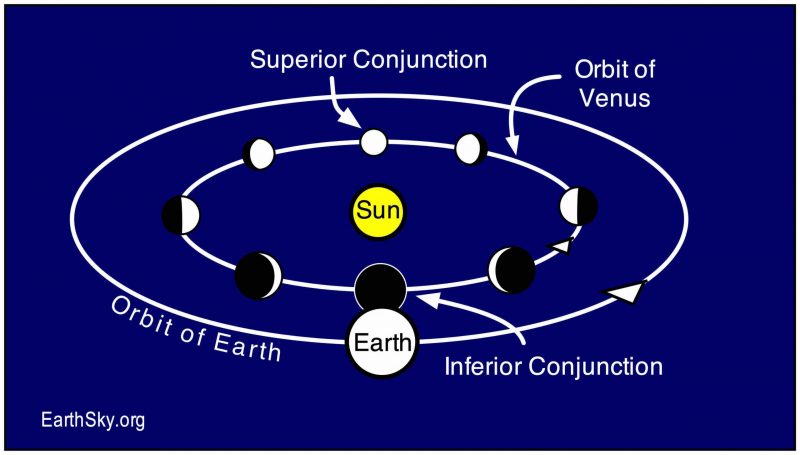The Whippet Special: Venus News Extra Extra
On this page

Hello!
There is a Venus/Mars conjunction happening in the sky and you can see it basically any morning for the next 3 mornings. (It's only a true conjunction on Friday 23 Australia time, but it's probably easier to see the day before/after, the Thursday and Saturday. That's Weds & Friday for most of the world.)
Anyway this is mainly an excuse to tell you some great facts I've been hoarding about Venus. But first: conjunction details.
It's neat because Venus and Mars are both bright, so it's an astronomical event you can see with the naked eye even with bad light pollution.
It's best seen 30-60 minutes before sunrise (between "astronomical twilight" and "nautical twilight" if your weather app gives you those times). Look for Venus in the east (it's the brightest 'star' in the sky) and then see Mars next to it, smaller and redder.
If you have a lot of obstacles on your horizon, you'll want to look closer to sunrise, when Venus and Mars are higher in the sky - but not so close to sunrise that the sky's too bright to see stars.
(New subscribers: this issue is different to usual ones. Heavier on dry details in case people want them. So maybe you'll like next issue better? Or worse! No writer really knows what subscribers like, but we have to make decisions as if we do.)

Venus traces a pentagram or rose in the sky over an 8-year cycle

This is 100% and literally the orbit of Venus from the perspective of Earth, over an 8-year cycle. Each 'petal' takes about 18 months.

Venus has been associated with roses for a very, very long time, at least 2-3000 BCE, with the Sumerian goddess Inanna (Ishtar in Akkadian/Babylonian), who was the planet Venus and had the rose as her symbol. Ancient roses were probably a species of dog rose, and looked like this – much more like the Venus astral rose-pattern than typical modern roses:

Here's the whole set (again this is not the orbit of the planet around the sun, it's how it looks from Earth):

The sun and moon aren't shown because they're simple from Earth's perspective, but they both make an "analemma" in the sky (an infinity symbol where one loop is bigger than the other), if you take a photo in the same place at the same time over the course of a year (sun) or month (moon).

The top/bottom of each sun loop shows the earliest and latest sunrise and sunset of the year, which is a little bit before or after the relevant solstice. (Ambiguous language because there's two hemispheres with two solstices each, which each have a sunrise and sunset). The 'crossing' point is not astronomically anything, but happens around the 15th of April and the 31st of August, if you want to celebrate.

The morning star and the evening star
Venus is always close to the sun, so you have to catch it in the window where it's in the sky, but the sun isn't.
Venus spends slightly over 9 months as a morning star (visible in the east just before dawn), disappears for a while, then re-emerges as the evening star (visible in the west just after sunset) for another 9ish months. This year, it disappears mid-May and will return as the Evening Star in early July (exact date depends on your distance from equator).
In Sumerian myth, those disappearances are "Inanna descending into the Underworld", but what's actually happening is a Sun/Venus conjunction: Venus is either behind the sun and hidden, or in front of it and invisible in the sun's brightness.

Each petal of the Venus rose takes ~18 months - the "inferior" conjunction is the beginning of a new petal, and the "superior" conjunction is the tip of the petal.
Venus is by far the brightest 'star' in the sky (almost twice as bright as Jupiter) so it tends to be important in world mythologies.
One way you can trace ancient culture's astronomy knowledge is via mythology: in Ancient Greece, the morning star and evening star were two brothers, Hesperus and Phosphorus. They didn't know the two 'stars' were the same. But by Alexander the Great times (300 BCEish), it has become a single goddess (Aphrodite), so we know their astronomy knowledge improved in that time.

OKAY SO PLEASE LET ME TELL YOU ABOUT INANNA DESCENDING INTO THE UNDERWORLD
aka the myth attached to Venus's regular disappearances. Complete shift from astronomy to mythology now:
Inanna aka Ishtar often gets presented by neo-pagans as just another face of the generic mother goddess, and I hate this, I hate that all the interesting spiky details get shaved off myths to make them fit into a monomyth.* She is a goddess of love, sex, war, and absolutely not motherhood.
I'm just going to give you this perfect one-sentence summary of Inanna's character, and you can decide if you like her:
"Inanna is an independent goddess who does as she pleases without regard for the consequences, then either manipulates, threatens, or tries to seduce others to fix the difficulties her own behaviour creates."
Our Lady of the Hot Mess.
* This happened a lot in the 70s, with feminists wanting to raise the profile of women and therefore female deities, but they did it by trying to say they were all the same, that all cultures and all times had venerated the mother, as a way to give goddess-worship legitimacy and mothers respect. But I think it's worse to turn all goddesses into mother-figures. Apart from anything else, Inanna would make a terrible mother.
So the myths and hymns are written in cuneiform on clay tablets, so they could be in any order, At first, early 1900s, they only had the tablets showing that Inanna's shepherd husband had been sent to the underworld, and that she went there too and returned alive. Mythologists had read the myths of Persephone and Orpheus, and had certain preconceptions about what shape this story would be. From this, you assume a rescue.
It took another 40 years before Samuel Noah Kramer deciphered the remaining text and learned the full story. I'm going to summarise it for you, because it's a delight:
- Inanna is Queen of Heaven and Earth, but wants to be Queen of the Underworld as well. She travels to the Underworld and knocks on the gate, demanding to be let in:
Gatekeeper, Lo! open thy gate!
Open thy gate that I may enter!
If thou openest not the gate to let me enter,
I will break the door, I will wrench the lock,
I will smash the door-posts, I will force the doors.
I will bring up the dead to eat the living.
And the dead will outnumber the living.
- The Queen of the Underworld, Ereshkigal, allows her in, but makes her strip off a piece of clothing or regalia at each of the seven gates, so Inanna arrives at the throneroom naked and bowed low.
- This does not in anyway discourage her from her original plan of usurping Ereshkigal's throne.
- She is immediately killed for her hubris and hung on a meathook.
- After she's been missing three days, her vizier goes around to the other gods asking for help to bring her back to life. They refuse, saying, more or less, "she had it coming, what did she think was going to happen?"
Inanna's father, the Moon god:
"My daughter craved the Great Above.
Inanna craved the Great Below.
She who receives the [power] of the underworld does not return.
She who goes to the Dark City stays there."
- Eventually the god Enki takes pity and agrees to help. (He often plays the role of "only person willing to put up with Inanna's bullshit.") He creates two genderless beings called the galatur and kurgarra. and gives them the food and water of life to revive Inanna with. [In the real world, Inanna's priest/esses were very often trans men and women. One of Inanna's powers is "to turn a man into a woman and a woman into a man"].
- Neat thing: the way the galatur and kurgarra are able to save Inanna is via empathy. They come across Ereshkigal in her throne room, a sweaty mess ("her hair swirled around her head like leeks"), moaning in pain. Every time she says "Ohhh my poor belly!", they repeat "Ohhh your poor belly!"
"Ohhh my poor heart!" she groans.
"Ohhh your poor heart!" they reply. Etc.
She's so appreciative, she says she'll give them anything they want as a thank-you. They ask for the meat hanging on the wall, which is Inanna. - Inanna is revived and escapes the Underworld, having learned zero lessons.
- Demons chase after her and say, "if you're leaving, then someone has to take your place in the Underworld. We're going to take your vizier."
Inanna: "No I need her."
Demons: "Fine, then we're taking your beautician."
Inanna: "No I need him."
Demons: "Fine, then we're taking your husband, Dumuzid."
Inanna: "Oh... go on then." - And that is how Dumuzid ends up in the Underworld.
(This story is also the origin of the barfly, as in the tiny persistent silent flies who hang around bins and fruit bowls and also bars, because of the smell of spilled beer and wine.
Inanna is looking for Dumuzid, and encounters a fly who asks, "what will you give me if I tell you where he is?"
She says "I will let you frequent the bars and taverns, where you can dwell among the talk of wise ones and the songs of minstrels".)
Note that there are a couple of different versions of the Descent myth (that we've found) - eg in the Akkadian version, she knocks on the gate of the Underworld and claims she wants to attend the funeral of Ereshkigal's husband, the Bull of Heaven. But Ereshkigal finds this suss because a) it's Inanna's fault the Bull of Heaven got killed, and b) Inanna is dressed in extremely fancy clothes and jewellery, not mourning clothes.
I've obviously paraphrased the story and left out elements, but it's basically right.
However, you will ALSO come across retellings that just completely butcher it to make it Jungian and paint Inanna in a better light (saying she was seeking wisdom, not power), or to make her a Jesus figure in order to "debunk" Christianity**, or, I wish I was joking, to make her a member of an alien race enslaving humanity with her superior technology. So stay safe out there.
** the idea of "what if my loved one who died could come back to life?" is an idea every grieving person independently comes up with, I don't think it requires prior mythological inspiration
Anyway, that's Inanna and I love her!
(Since it's a Venus/Mars conjunction, I guess I should have said something about Mars? Ummm in Sumerian mythology, Mars is Nergal, a god of war and plagues, a name you may recognise if you played Warhammer)


go look at planets 🙏

Comments
Sign in or become a Whippet subscriber (free or paid) to add your thoughts.
Just enter your email below to get a log in link.
A newsletter for the terminally curious
Arrives in your inbox every second Thursday.
